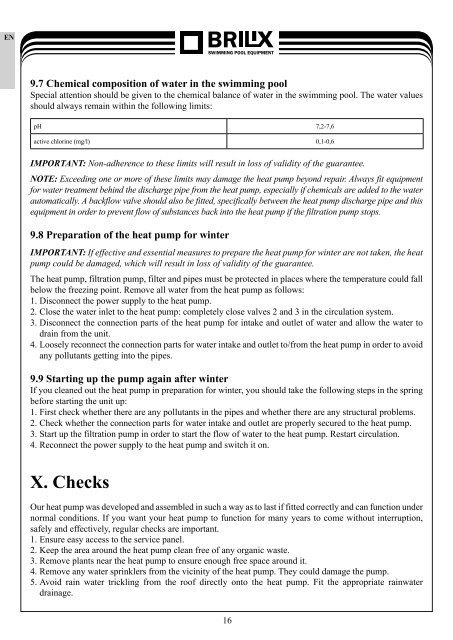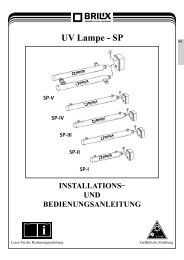swimming pool heat pump installation and user guide - BRILIX.com
swimming pool heat pump installation and user guide - BRILIX.com
swimming pool heat pump installation and user guide - BRILIX.com
You also want an ePaper? Increase the reach of your titles
YUMPU automatically turns print PDFs into web optimized ePapers that Google loves.
EN<br />
9.7 Chemical <strong>com</strong>position of water in the <strong>swimming</strong> <strong>pool</strong><br />
Special attention should be given to the chemical balance of water in the <strong>swimming</strong> <strong>pool</strong>. The water values<br />
should always remain within the following limits:<br />
pH 7,2-7,6<br />
active chlorine (mg/l) 0,1-0,6<br />
IMPORTANT: Non-adherence to these limits will result in loss of validity of the guarantee.<br />
NOTE: Exceeding one or more of these limits may damage the <strong>heat</strong> <strong>pump</strong> beyond repair. Always fit equipment<br />
for water treatment behind the discharge pipe from the <strong>heat</strong> <strong>pump</strong>, especially if chemicals are added to the water<br />
automatically. A backflow valve should also be fitted, specifically between the <strong>heat</strong> <strong>pump</strong> discharge pipe <strong>and</strong> this<br />
equipment in order to prevent flow of substances back into the <strong>heat</strong> <strong>pump</strong> if the filtration <strong>pump</strong> stops.<br />
9.8 Preparation of the <strong>heat</strong> <strong>pump</strong> for winter<br />
IMPORTANT: If effective <strong>and</strong> essential measures to prepare the <strong>heat</strong> <strong>pump</strong> for winter are not taken, the <strong>heat</strong><br />
<strong>pump</strong> could be damaged, which will result in loss of validity of the guarantee.<br />
The <strong>heat</strong> <strong>pump</strong>, filtration <strong>pump</strong>, filter <strong>and</strong> pipes must be protected in places where the temperature could fall<br />
below the freezing point. Remove all water from the <strong>heat</strong> <strong>pump</strong> as follows:<br />
1. Disconnect the power supply to the <strong>heat</strong> <strong>pump</strong>.<br />
2. Close the water inlet to the <strong>heat</strong> <strong>pump</strong>: <strong>com</strong>pletely close valves 2 <strong>and</strong> 3 in the circulation system.<br />
3. Disconnect the connection parts of the <strong>heat</strong> <strong>pump</strong> for intake <strong>and</strong> outlet of water <strong>and</strong> allow the water to<br />
drain from the unit.<br />
4. Loosely reconnect the connection parts for water intake <strong>and</strong> outlet to/from the <strong>heat</strong> <strong>pump</strong> in order to avoid<br />
any pollutants getting into the pipes.<br />
9.9 Starting up the <strong>pump</strong> again after winter<br />
If you cleaned out the <strong>heat</strong> <strong>pump</strong> in preparation for winter, you should take the following steps in the spring<br />
before starting the unit up:<br />
1. First check whether there are any pollutants in the pipes <strong>and</strong> whether there are any structural problems.<br />
2. Check whether the connection parts for water intake <strong>and</strong> outlet are properly secured to the <strong>heat</strong> <strong>pump</strong>.<br />
3. Start up the filtration <strong>pump</strong> in order to start the flow of water to the <strong>heat</strong> <strong>pump</strong>. Restart circulation.<br />
4. Reconnect the power supply to the <strong>heat</strong> <strong>pump</strong> <strong>and</strong> switch it on.<br />
X. Checks<br />
Our <strong>heat</strong> <strong>pump</strong> was developed <strong>and</strong> assembled in such a way as to last if fitted correctly <strong>and</strong> can function under<br />
normal conditions. If you want your <strong>heat</strong> <strong>pump</strong> to function for many years to <strong>com</strong>e without interruption,<br />
safely <strong>and</strong> effectively, regular checks are important.<br />
1. Ensure easy access to the service panel.<br />
2. Keep the area around the <strong>heat</strong> <strong>pump</strong> clean free of any organic waste.<br />
3. Remove plants near the <strong>heat</strong> <strong>pump</strong> to ensure enough free space around it.<br />
4. Remove any water sprinklers from the vicinity of the <strong>heat</strong> <strong>pump</strong>. They could damage the <strong>pump</strong>.<br />
5. Avoid rain water trickling from the roof directly onto the <strong>heat</strong> <strong>pump</strong>. Fit the appropriate rainwater<br />
drainage.<br />
16






